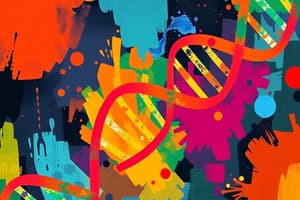Podcast
Questions and Answers
What role do diatoms play in forensic investigations related to drowning?
What role do diatoms play in forensic investigations related to drowning?
- They suggest the victim was alive when they entered the water. (correct)
- They indicate the presence of toxins in the body.
- They confirm the time of death.
- They assist in identifying genetic disorders.
Which of the following is a method of testing for Creutzfeldt-Jakob Disease?
Which of the following is a method of testing for Creutzfeldt-Jakob Disease?
- Stomach content analysis for toxins.
- Testing of the brain for prion activity. (correct)
- Examination of lung tissues for fat embolism.
- Analysis of kidney tissue for diatoms.
What does the examination of stomach contents usually aim to determine in forensic cases?
What does the examination of stomach contents usually aim to determine in forensic cases?
- Possible toxins related to poisoning. (correct)
- Histological changes in tissues.
- Presence of diatoms.
- Evidence of ischemic heart disease.
Why is the examination of fat embolism important in forensic pathology?
Why is the examination of fat embolism important in forensic pathology?
In cases of putrefaction when blood analysis is unavailable, which of the following fluids could be examined?
In cases of putrefaction when blood analysis is unavailable, which of the following fluids could be examined?
What role does a forensic scientist play in criminal investigations involving biological materials?
What role does a forensic scientist play in criminal investigations involving biological materials?
Which of the following biological materials can be collected from living persons for forensic analysis?
Which of the following biological materials can be collected from living persons for forensic analysis?
Where should blood samples be taken from cadavers to prevent contamination?
Where should blood samples be taken from cadavers to prevent contamination?
What substances can the analysis of blood samples from living persons detect?
What substances can the analysis of blood samples from living persons detect?
Which material offers a broader spectrum of obtained samples for forensic analysis?
Which material offers a broader spectrum of obtained samples for forensic analysis?
What is preserved in blood samples to prevent changes during analysis?
What is preserved in blood samples to prevent changes during analysis?
Collecting blood from hematomas can provide retrospective analysis for which of the following reasons?
Collecting blood from hematomas can provide retrospective analysis for which of the following reasons?
Which type of biological sample is collected via breathalyzer equipment?
Which type of biological sample is collected via breathalyzer equipment?
Flashcards
Diatoms in Kidneys
Diatoms in Kidneys
The presence of diatoms in the kidneys suggests that the victim was alive when they entered the water. Diatoms are microscopic algae found in water that enter the lungs during drowning. They then pass into the bloodstream and become trapped in the kidneys.
What can diatoms in the kidneys indicate?
What can diatoms in the kidneys indicate?
Testing for the presence of diatoms in the kidneys can help determine if a person drowned, as they are microscopic algae that enter the lungs during drowning. The diatoms then pass into the bloodstream and get trapped in the kidneys, suggesting the victim was alive when they entered the water.
What is Jakob-Creutzfeldt disease (CJD)?
What is Jakob-Creutzfeldt disease (CJD)?
Jakob-Creutzfeldt disease (CJD) is a rare, fatal brain disorder caused by prions, which are misfolded proteins. These prions cause abnormal folding of normal proteins in the brain, leading to damage.
What is a fat embolism?
What is a fat embolism?
Signup and view all the flashcards
What is a histological examination?
What is a histological examination?
Signup and view all the flashcards
Forensic Scientist Role
Forensic Scientist Role
Signup and view all the flashcards
Biological Material from Living Persons
Biological Material from Living Persons
Signup and view all the flashcards
Blood Sampling from Living Persons
Blood Sampling from Living Persons
Signup and view all the flashcards
Urine Sampling from Living Persons
Urine Sampling from Living Persons
Signup and view all the flashcards
Alveolar Air Sampling
Alveolar Air Sampling
Signup and view all the flashcards
Biological Material from Cadavers
Biological Material from Cadavers
Signup and view all the flashcards
Blood Sampling from Cadavers
Blood Sampling from Cadavers
Signup and view all the flashcards
Sequestered Hematomas
Sequestered Hematomas
Signup and view all the flashcards
Study Notes
Forensic Collection of Biological Material
- Forensic scientists are crucial for collecting and investigating biological traces (blood, saliva, semen, urine, feces) in criminal investigations, especially in violent crimes.
- This work helps to establish facts like DNA matches, blood stain patterns, and links between biological material and suspects/victims.
- Obtaining biological material requires collaboration with various specialists (toxicologists, microbiologists, geneticists, pathologists).
- Accuracy of analysis depends on quality of the specimen.
Obtaining Samples from Living Persons
- Obtaining material is limited compared to cadavers.
- Blood: Collected from the cubital vein using non-alcoholic disinfectants to avoid ethanol contamination. Preserved with sodium fluoride (NaF). Used for detecting ethanol, drugs, volatile compounds, poisons, and determining therapeutic/toxic doses.
- Urine: Useful for detecting metabolites and drugs (including ethanol and heavy metals).
- Alveolar air (breath): Collected using a breathalyzer to detect ethanol.
- Other samples include saliva, stomach contents, hair, nails, and vaginal swabs.
Obtaining Samples from Cadavers
- Obtaining material is more extensive than living persons.
- Blood: Collected from the femoral vein. Avoid body cavities to prevent contamination. Water content of blood varies between clotted and liquid forms.
- Sequestered hematomas (blood collections) can provide retrospective analysis, especially useful for blood factors present at the time of death or injury. These can be located in various areas (e.g., subdural, epidural spaces, muscles, subcutaneous tissues, retroperitoneal space).
- Blood analysis determines presence of ethanol, drugs, carbon monoxide, methanol, acetone, etc.
- Urine: Obtained from the bladder or drainage bags. Concentration of substances depends on voiding frequency.
- If no specimen collected, testing may be possible after analysis of blood.
- Kidney: Diatoms can be used in drowning cases. Diatoms (microscopic algae), present in water, enter lungs during drowning, and are found in the kidneys, indicating drowning while alive.
- Brain: Tested for Jakob-Creutzfeldt disease (caused by prions).
- Lung: Examined for fat embolism (evidence of prior trauma to long bones - fracture where fats from marrow enter bloodstream and travel to lungs).
- Heart: Examination for evidence of ischemic heart disease.
- Vitreous humor: Fluid in the eye; tested in blood unavailability cases.
- Synovial fluid: Fluid in joints
- CSF: Cerebrospinal fluid; tested in blood unavailability cases
- Stomach content: Analyzed for toxins in poisoning cases.
- All tissues: Histological examination (tissue study).
Studying That Suits You
Use AI to generate personalized quizzes and flashcards to suit your learning preferences.
Description
Explore the techniques and significance of collecting biological samples in forensic science. This quiz covers the processes for obtaining and analyzing blood, urine, and other biological materials crucial for criminal investigations. Understand the importance of collaboration with specialists and the factors that influence specimen quality.




